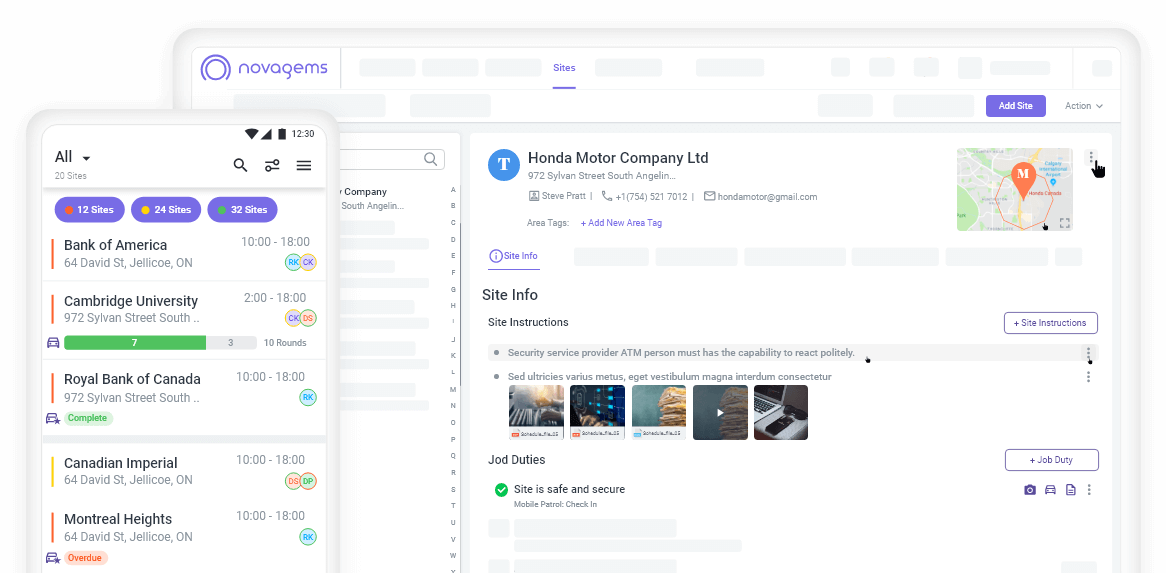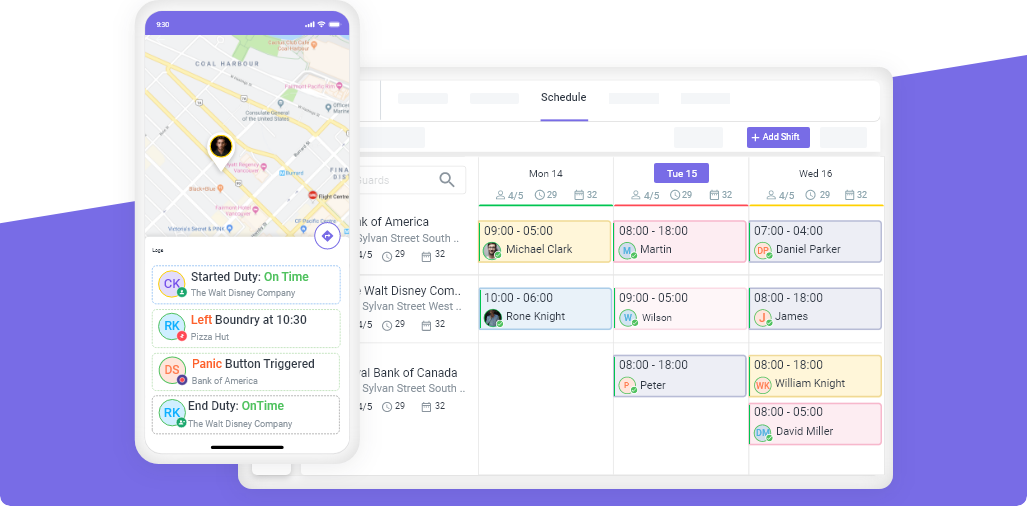A Complete Guide to Managing Rotating Shift Schedules
Published on: Wed, Apr 2, 2025
Read in 9 minutes

Key takeaways
- Rotating shift schedules involve employees working different shifts, ensuring continuous operations while balancing work distribution.
- There are various types of rotating shifts, including frequent, slow, weekend, DuPont, and Panama schedules, each with unique benefits.
- Creating a rotating shift schedule requires considering business needs and employee preferences, and scheduling software can help manage it.
- Rotating shifts offer fairness by distributing tough shifts, flexibility and can improve overall employee satisfaction.
Managing rotating shift schedules is an essential part of many industries that require constant operation, such as healthcare, manufacturing, and customer service. A rotating shift schedule involves alternating employees between different shifts, including day shifts, evening shifts, and night shifts. This ensures that the workforce can cover all hours of the day while giving employees a fair distribution of shift types.
However, creating and managing rotating shifts can be complex. It requires balancing operational needs with employee well-being. In this guide, we will explain what rotating shift schedules are, the types of shift schedules, how to create one, and the benefits and challenges associated with it. We will also provide tips for using scheduling software to streamline staff scheduling.
What Are Rotating Shift Schedules?
A rotating shift schedule is a type of work schedule where employees alternate between working different shifts over a set period. For example, one employee may work day shifts for a week, followed by evening shifts the next week, and then night shifts the week after that. This rotating pattern continues for as long as the schedule is in place.
The goal of a rotating shift schedule is to ensure that all shifts are covered, especially in businesses that operate 24/7. Rotating shifts help prevent one group of employees from always working undesirable shifts, like night shifts or weekends. However, rotating shifts also present challenges, such as disrupted sleep patterns and difficulty adjusting to new work schedules.
Types of Rotating Shift Schedules
There are several types of rotating shift schedules that businesses can use. Each type has its own advantages and disadvantages, depending on the needs of the business and the preferences of the employees.
1. Frequent Rotating Shifts
In a frequent rotating shift schedule, employees rotate between different shifts (day, evening, and night) on a regular basis, such as weekly or biweekly. This system ensures that each employee experiences a fair distribution of shifts. However, frequent rotations can be tough on employees, as it disrupts their sleep patterns and makes it difficult to adjust to new shifts.
2. Slow Rotating Shifts
In slow rotating shifts, employees stay on the same shift for a longer period before rotating to the next shift. For example, an employee may work the day shift for two weeks, followed by two weeks on the night shift. This schedule allows employees to get used to one shift before moving to another, but it can mean that certain shifts, like night shifts, are less desirable for longer periods.
3. Weekend Rotating Shifts
This type of rotating shift involves employees rotating through weekend shifts. In industries where weekend coverage is essential, a rotating weekend shift schedule ensures that no single employee is always working on weekends. Employees might work on weekends every other week, depending on the rotation pattern.
4. DuPont Schedule
The DuPont schedule is a 12-hour shift pattern that involves four teams. Employees work two consecutive day shifts, followed by two night shifts, and then get four days off. This schedule allows for long periods of rest, but it requires careful planning to prevent burnout from long shifts.
5. Panama Schedule
The Panama schedule follows a 2-2-3 pattern, where employees work two 12-hour shifts, then have two days off, followed by three 12-hour shifts. This schedule repeats every two weeks, giving employees long weekends every other week. While the schedule ensures 24/7 coverage, it can be physically demanding for employees.
How to Create a Rotating Work Schedule
Creating a rotating shift schedule requires careful planning to meet both business and employee needs. Here’s how to create an effective rotating shift schedule:
1. Assess Your Operational Needs
Before creating a shift schedule, it’s essential to assess your operational needs. Determine the hours that require coverage, especially during peak times, and figure out how many employees are needed for each shift. This will help you decide how to structure your rotating shifts.
2. Understand Employee Preferences
Employee satisfaction is key to an effective rotating shift schedule. Talk to your staff about their preferences for certain shifts, whether they prefer day shifts or would like more weekend time off. While it’s not always possible to accommodate everyone’s preferences, understanding their needs will help you create a more balanced work schedule.
3. Choose the Right Rotation Pattern
Once you know the coverage needed and employee preferences, choose a rotation pattern that suits your business. A weekly work schedule template may help you visualize how the shifts will rotate. Whether you go with frequent or slow rotation depends on the type of work and how much time employees need to adjust between shifts.
4. Ensure Compliance with Labor Laws
Labor laws set limits on how long employees can work, how many hours of rest they must have between shifts, and how much overtime is allowed. Make sure your rotating schedule complies with these regulations to avoid legal issues.
5. Use Scheduling Software
Using scheduling software is a great way to simplify staff scheduling. Scheduling software can help you manage rotating shifts, track work hours, and ensure that shifts are filled correctly. It can also provide employees with an easy way to view their schedules and request time off. Tools like these can save time and reduce errors when creating rotating work schedules.
6. Monitor and Adjust as Needed
After implementing your rotating shift schedule, monitor how it’s working. Ask employees for feedback and look for signs of burnout or dissatisfaction. If needed, adjust the schedule to make it more effective for everyone.
7. Provide Clear Communication
Clear communication is vital when managing rotating shifts. Ensure that employees know well in advance when their shifts will change. This helps employees prepare for the transition and reduces confusion.
Examples of Rotating Shift Schedules
To help visualize how rotating shifts work, here are a couple of examples:
1. Weekly Rotation Schedule
Week 1:
- Monday to Friday: 9:00 AM to 5:00 PM (Day Shift)
- Saturday: 4:00 PM to 12:00 AM (Evening Shift)
- Sunday: 12:00 AM to 9:00 AM (Night Shift)
Week 2:
- Monday to Friday: 4:00 PM to 12:00 AM (Evening Shift)
- Saturday: 12:00 AM to 9:00 AM (Night Shift)
- Sunday: 9:00 AM to 5:00 PM (Day Shift)
This type of weekly rotation ensures that all shifts are covered while allowing employees to experience each shift over time.
2. DuPont Schedule
Week 1:
- Monday to Wednesday: 7:00 AM to 7:00 PM (Day Shift)
- Thursday to Friday: Off
- Saturday to Sunday: 7:00 PM to 7:00 AM (Night Shift)
Week 2:
- Monday to Wednesday: Off
- Thursday to Saturday: 7:00 AM to 7:00 PM (Day Shift)
- Sunday: 7:00 PM to 7:00 AM (Night Shift)
The DuPont schedule offers employees significant rest, but the long shifts can be tiring.
Benefits of Rotating Shift Schedules
Rotating shift schedules have several advantages:
1. Fair Distribution of Shifts
A rotating shift schedule helps distribute shifts more evenly among employees, ensuring that no one person is always stuck working nights or weekends. This fairness improves employee satisfaction and reduces resentment.
2. Better Coverage
Rotating shifts allow businesses to maintain full coverage, even during non-business hours. This is essential in industries like healthcare and customer service, where operations need to run 24/7.
3. Flexibility for Employees
Rotating schedules can offer flexibility for employees, especially when they can choose from different shift patterns. Some employees may prefer working night shifts while others may prefer weekends off. A flexible rotating shift schedule can provide a better work-life balance.
4. Improved Employee Morale
When employees don’t have to work undesirable shifts for long periods, their morale tends to improve. A fair distribution of shifts helps reduce fatigue and burnout, leading to better job satisfaction.
Challenges of Rotating Shift Schedules
While rotating shifts offer many benefits, they also come with challenges:
1. Health Issues
Rotating shifts, particularly night shifts, can have negative effects on employees’ health. Disruptions to sleep patterns, fatigue, and increased stress levels can lead to burnout and health problems over time.
2. Impact on Personal Life
Irregular work hours can interfere with employees’ personal lives. Rotating shifts may make it difficult for employees to spend time with family or maintain a social life.
3. Complexity in Scheduling
Managing rotating shifts can be complicated, especially when dealing with a large team. It requires careful planning to ensure that the shifts are adequately covered and that employees are given enough rest between shifts.
4. Employee Resistance
Some employees may be resistant to rotating shifts, especially if they prefer a regular schedule. The transition from a fixed schedule to a rotating one can be difficult for some.
How Novagems Makes Rotating Shift Scheduling Easier
Managing rotating shift schedules can be tricky, but Novagems makes it easier. It has an easy-to-use system that helps businesses manage employee schedules, making sure every shift is covered and everything runs smoothly.
Key Features:
- Automated Scheduling: Novagems helps in creating rotating shift schedules with custom templates, saving time and reducing mistakes.
- Real-Time Updates: Both managers and employees get instant notifications if there are any schedule changes, so everyone knows what’s going on.
- GPS Tracking & Geofencing: You can track where employees are working to make sure they are at the right location during their shift.
- Time Tracking: It keeps track of working hours, overtime, and breaks to make sure the schedule follows the law.
Novagems offers a free 14-day trial so businesses can try it out without any cost. With Novagems, businesses can make rotating shift scheduling much easier, improve efficiency, and keep employees happy.
Conclusion
Managing a rotating shift schedule requires balancing the needs of the business with the well-being of employees. By using a weekly work schedule template, utilizing scheduling software, and considering employee preferences, businesses can create a fair and efficient rotating shift schedule. While there are challenges, the benefits of rotating shifts, such as improved coverage, better employee morale, and fairer distribution of work, make it a viable option for many businesses. With careful planning and consideration, rotating shifts can lead to a more productive and satisfied workforce.
Get a Free Trial
Sign up For Newsletter
Latest Blog Posts
Get Started
Start being productive & grow your business
with Novagems





